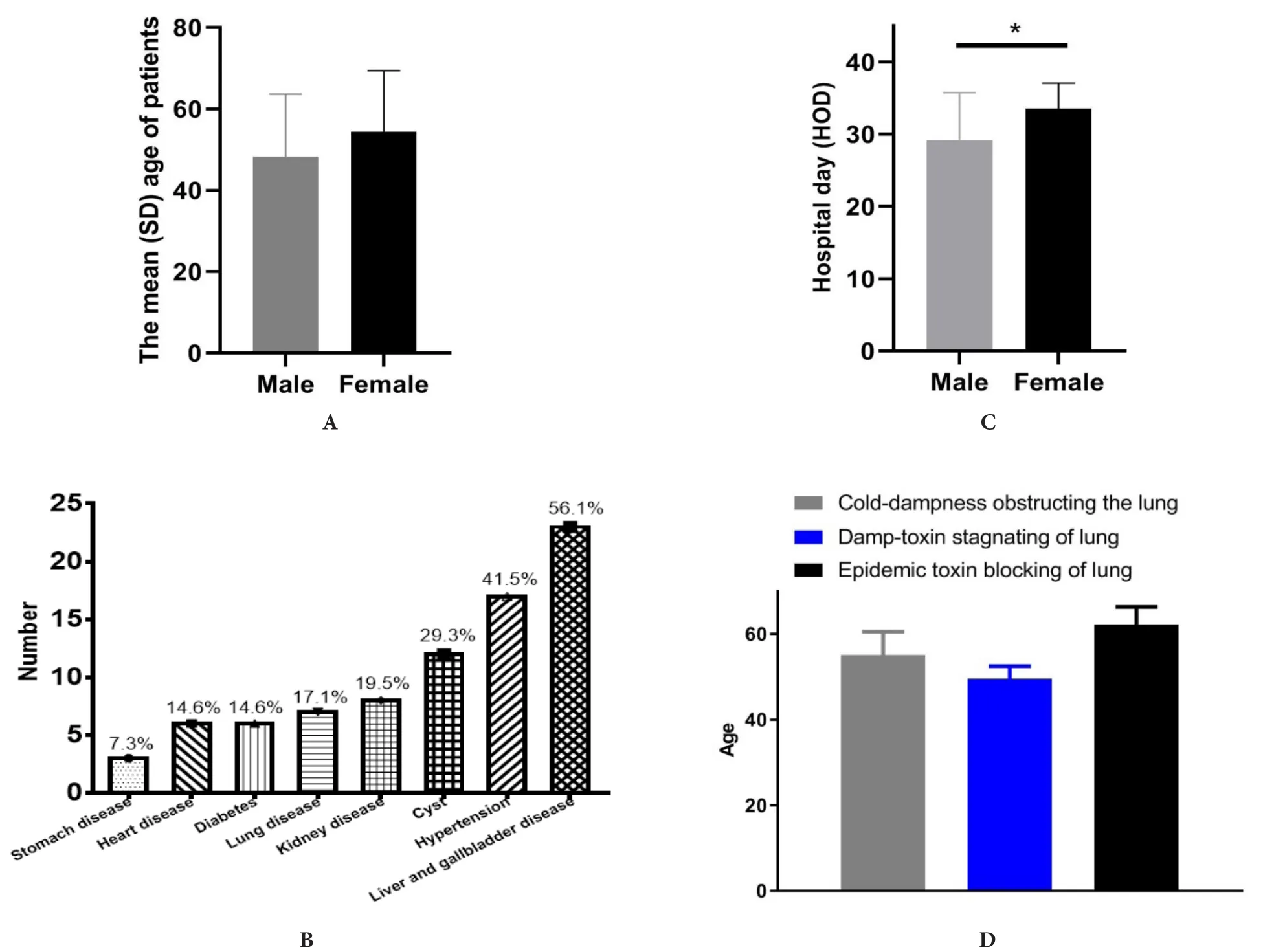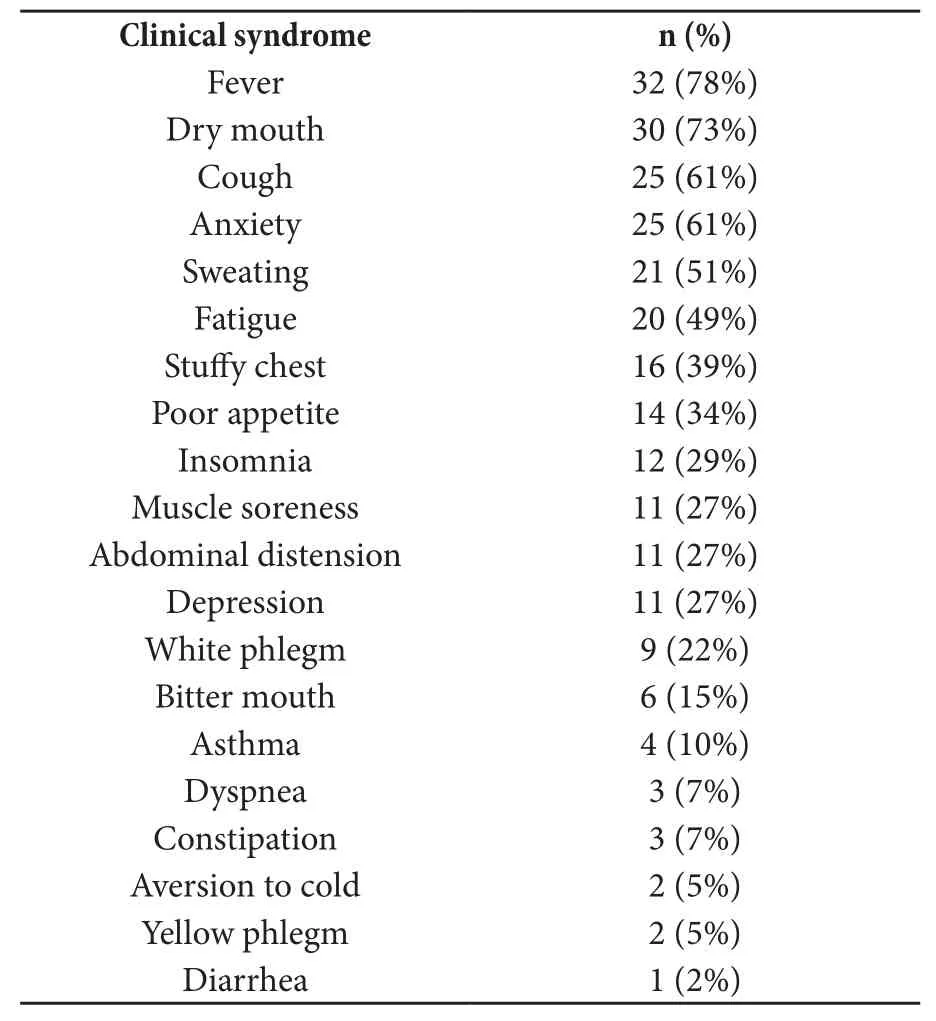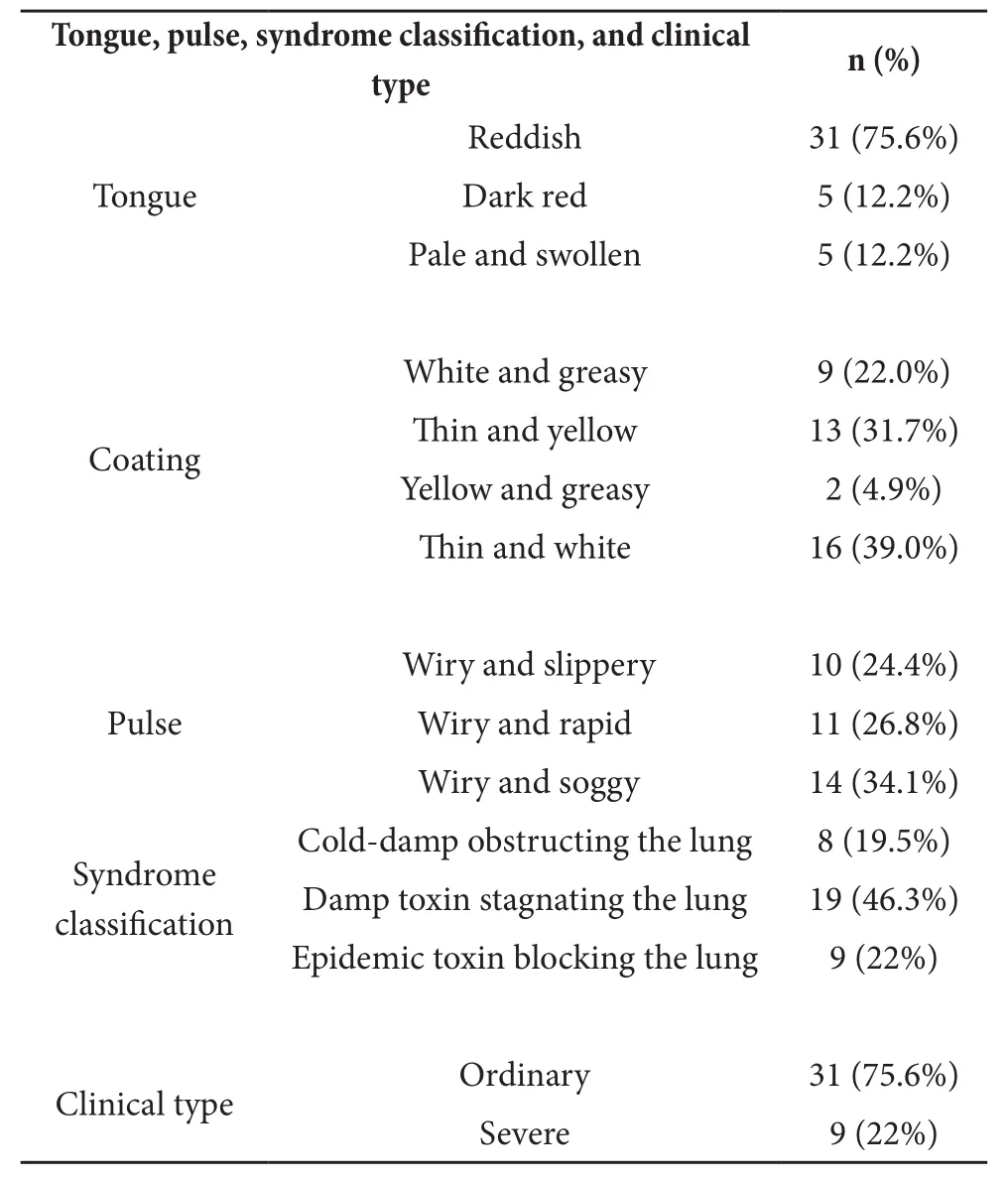Clinical Syndrome Types of Patients with Coronavirus Disease 2019 Based upon Traditional Chinese Medicine
2020-10-16XiufangDingZhihongTanMeiyingZhangBoyuHanShengfangZhouChaanPengYinLongYuWeiDiMiaoHongyanWanZhiJunTianYuanliWangJihongZhangYanliLuJiaxuChen
Xiu-fang Ding,Zhi-hong Tan,Mei-ying Zhang,Bo-yu Han,Sheng-fang Zhou,Cha-an Peng,Yin Long,Yu Wei ,Di Miao,Hong-yan Wan,Zhi-Jun Tian,Yuan-li Wang,Ji-hong Zhang *,Yan-li Lu *,Jia-xu Chen
1.Beijing Longfu Hospital,Beijing 100010,China
2.Beijing Institute of Integrated Traditional Chinese and Western Medicine for Elderly Health,Beijing 100010,China
3.Institute of Chinese and Western Medicine,The Second People’s Hospital of China Three Gorges University,Yichang 443000,Hubei Province,China
4.Rehabilitation institute,the First People’s Hospital of Yichang,Yichang 443000,Hubei Province,China
5.Jiangnan-Branch,Yichang Center Hospital,Yichang 443000,Hubei Province,China
6.School of Chinese Medicine,Beijing University of Chinese Medicine,Beijing 100029,China
Abstract
Key words:Clinical syndrome types; Coronavirus disease 2019; Traditional Chinese medicine
Introduction
In December 2019,the coronavirus disease 2019 (COVID-19)was discovered and identified in the viral pneumonia cases that occurred in Wuhan,the capital city of Hubei Province,China.The Government of the People’s Republic of China made urgent decisions to control and prevent the spread of the epidemic (Xu et al.,2020)[1].For instance,the Chinese government classified COVID-19 as a Class B infectious disease and treated it as Class A on January 20,2020 (Guideline on diagnosis and treatment of COVID-19,2020).A total of 11,901 cases were laboratoryconfirmed and 259 died (National Health Commission Update on February 2,2020 [(Liu,et al.,)][2].The World Health Organization (WHO) then classified the disease on February 22,2020.At present,the cumulative number of diagnoses worldwide is 19,200,000.Therefore,the increasing number of cases caused a worldwide panic(Jin et al.,2020)[3].COVID-19 is the seventh member of the coronavirus family that can infect humans.A recent research showed that fever,dry cough,and fatigue were key symptoms,whereas nasal congestion,runny nose,pharyngalgia,myalgia,and diarrhea were less common symptoms (Guideline on diagnosis and treatment of COVID-19,2020)[4-5].
A large number of studies have shown that traditional Chinese medicine (TCM) can treat viral respiratory diseases from multiple targets,multiple mechanisms,and multiple signal pathways,regulate the immune function of the body,and play an antiviral effect to prevent and treat the viral infection.For example,severe acute respiratory syndrome (SARS) patients who underwent TCM therapies benefited from the decrease in steroid-related side effects,shorter hospitalization,improvement of symptoms,etc.(Ling et al.,2020)[6].Genomic and in silico structural characterization of COVID-19 showed that it is very closely related to the SARS coronavirus,indicating that TCM may be useful in managing the current outbreak (Wu et al.,2020)[1].Indeed,the government is advising doctors to consider integrating the Western antiviral drugs with Chinese medicine remedies in combating COVID-19.
In ancient Chinese medicine,the books entitled Inner Canon of Yellow Emperor (Pre-Qin/Han Dynasty,about more than 2,000 years ago),Treatise on Cold Pathogenic and Miscellaneous Diseases (A.D.219,Han Dynasty),and Detailed Analysis of Epidemic Warm Diseases (Qin Dynasty,1644—1911) recorded that this kind of disease is caused by an infectious Qi resulting from the variation of the season,climate,environment,people’s living habits,etc.
Therefore,this study aims to explore the association between the laboratory results of Western medicine and the different TCM syndrome types in COVID-19 patients.To explore the association between the laboratory results of Western medicine and the different TCM syndrome types in COVID-19 patients,epidemiological data,results of the biochemical examination and chest computed tomography (CT) scans,and other clinical data (syndrome types,color of tongue and coat,and pulse) were obtained from the COVID-19 patients in Yichang City,Hubei Province,and TCM syndrome differentiation in TCM was performed (Guideline on diagnosis and treatment of COVID-19,2020)[4-5].
Methods
Study participants
The consecutive in-patients admitted to the Jiangnan Branch,Yichang Center Hospital,with laboratoryconfirmed COVID-19 were included in this retrospective study,which was conducted from January 15 to April 15,2020.Moreover,the Jiangnan Branch,Yichang Center Hospital,Hubei Province,China,was assigned to be responsible for the treatment of COVID-19 patients by the Yichang government.The patients enrolled in this study were diagnosed according to WHO interim guidance(World Health Organization.2020)[4-5].The cases without the epidemiological data,results of the biochemical examination,and other clinical data (syndrome types,the color of tongue and coat,and pulse) were excluded.This study was approved by the institutional ethics committee of the hospital (No.LFYY2020-1),with a waiver of the informed consent.
Data collection
The demographic characteristics (age and gender) and clinical data (syndrome types,comorbidities,laboratory findings,complications,color of tongue and coat,and pulse) of the patients during hospitalization were obtained from electronic medical records by two investigators(Z.H.T.and M.Y.L.).The radiologic assessments included chest radiography or CT.All data were independently reviewed and entered into the computer database by two analysts (X.F.D.and B.Y.H.).The TCM syndrome classification and stages were judged according to the guidelines (Jin et al.,)[3].The length of hospitalization stay and discharges were monitored until April 15,2020.The final date of follow-up was August 15,2020.
Statistical analysis
All data were analyzed using the SPSS 18.0 software.The data of normal distribution were expressed as mean ±standard deviation (SD).The mean values were performed by using the one-way analysis of variance followed by the least significant difference test for post hoc comparisons when equal variances were assumed.The matched-pairs chi-square test was used for enumeration data,and the independent samples t test or rank-sum test was used for data measurement.The values of p < 0.05 were considered statistically significant.
Results
Basic characteristics of COVID-19 patients
Among the 120 patients in the medical record system who were screened initially,59 without full available medical information and duplicated records and 20 with missing results in their laboratory examination (e.g.,ALT and CKMB) were excluded.Finally,the study population included 41 patients hospitalized with confirmed COVID-19.Moreover,all the patients had exposure histories of direct or indirect close contact with confirmed COVID-19 patients (Table 1).The mean age of the patients was 51 years (Table 1).There were 27 (65.9%) female patients,with a mean age of 54 years,and 14 (34.1%) male patients,with a mean age of 48 years.However,no statistically significant association between gender and the mean age was observed (Figure 1A,p > 0.05).Among these patients,fever (41 patients [100%]) was the most common symptom.The mean of temperature was 37.6℃.Moreover,87% of the patients had underlying diseases (Table 1).Chronic liver and gallbladder disease (56.1%) and hypertension (41.5%) were the most common coexisting conditions.Cyst (29.3%),chronic kidney disease (19.5%),chronic lung disease (17.1%),diabetes (14.6%),heart disease (14.6%),and chronic stomach disease (7.3%) were rare (Figure 1B).The mean hospital day (HOD) of the female and male patients were 34 and 29,respectively.Furthermore,a significant association between gender and HOD was observed (p=0.03,p < 0.05) (Figure 1C).

Table 1 Basic characteristics of confirmed COVID-19 patients

Figure 1 Basic characteristics and the association between syndrome type and age in COVID-19 patients.
Clinical syndrome types of patients based on TCM theory
Most of the cases developed fever (78%),dry mouth (73%),cough (61%),anxiety (61%),spontaneous sweating (51%),and fatigue (49%).The patients also presented with the following symptoms:stuffy chest (39%),poor appetite(34%),insomnia (29%),muscle soreness (27%),abdominal distension (27%),depression (27%),white phlegm (22%),bitter mouth (15%),and asthma (10%).However,dyspnea(7%),constipation (7%),aversion to cold (5%),yellow phlegm (5%),and diarrhea (2%) were rare among the patients (Table 2).

Table 2 Clinical syndrome types of COVID-19 patients based on the traditional Chinese medicine theory
The color of tongue and coat,pulse,and syndrome classification
The data on the patients with reddish tongue (75.6%),dark red tongue (12.2%),and pale and swollen tongue(12.2%) were obtained.In addition,the patients had the following characteristics:white and greasy fur (22%),thin and yellow fur (31.7%),yellow and greasy fur (4.9%),and thin and white fur (39%) (Table 3).For pulse taking,the following data on the patients’ pulse were obtained:wiry and slippery (24.4%),wiry and rapid (26.8%),and wry and soggy (34.1%) (Table 3).According to the above information and the clinical syndrome types based on TCM theory (Table 2),cold-damp obstructing the lung(19.5%),damp toxin stagnating the lung (46.3%),and epidemic toxin blocking the lung (22%) were the most common (Table 4,Figure 2).Among all the cases,75.6%were ordinary type and 22% were severe type,which was graded according to the guideline of PC-NCP7 (Jin et al.,2020)[3].

Table 3 The tongue,pulse,and syndrome classification of COVID-19 patients (n=41)

Table 4 Distribution of ALT,AST,CK,CK-MB,WBC,LYM,and CRP in male and female COVID-19 patients (n=41)

Figure 2 The images of the tongue in the most common syndrome types in COVID-19 patients
The distribution characteristics in different syndrome types
The mean age of the patients presenting with colddamp obstructing the lung was 55.13 ± 5.38 years,with a proportion of 20%,and the percentages of male and female patients with this syndrome type were all 50%.The mean age of those presenting with damp toxin stagnating the lung was 49.58 ± 2.86 years,with a proportion of 46.3%,and the percentages of male and female patients with this syndrome type were 26.3% and 73.7%,respectively.Moreover,the mean age of those presenting with epidemic toxin blocking the lung was 62.2 ± 4.1 years,with a proportion of 22%,and the percentages of male and female patients with this syndrome type are 22.2% and 77.8%,respectively.However,no significant association regarding gender,age,and syndrome type was observed (p> 0.05)(Figure 1D).
The distribution characteristics of the biochemical examination of patients with different syndrome types
The chest CT scans of all patients showed a ground glass shadow on both lungs.ALT [18,(43.9%)],AST [13(31.7%)],CK [19,(46.3%)],CK-MB [13 (31.7%)],and CRP [21 (24.4%)]in-patients were increased,and WBC[10 (24.4%)]and LYM [19 (46.3%)]were decreased.Except for the distribution of CK (p=0.021,p < 0.05),no significant difference in the distribution of ALT,AST,CK,CK-MB,WBC,LYM,and CRP between male and female COVID-19 patients was observed (Table 5).
For patients presenting with cold dampness obstructing the lung,the percentages of the abnormal levels of ALT,AST,CK,CK-MB,WBC,LYM,and CRP were 25%,25%,37.5%,50%,25%,25%,and 62.5%,respectively (Table 5).For those presenting with damp toxin stagnating the lung,the percentages of the abnormal levels of ALT,AST,CK,CK-MB,WBC,LYM,and CRP were 52.6%,36.8%,5.3%,26.3%,26.3%,42.1%,and 52.6%,respectively.Moreover,for those presenting with epidemic toxin blocking the lung,the percentages of the abnormal levels of ALT,AST,CK,CK-MB,WBC,LYM,and CRP were 44.4%,33.3%,11.1%,22.2%,11.1%,77.8%,and 66.7%,respectively(Table 5).Furthermore,no significant difference in the distribution of the results of the biochemical examination(ALT,AST,CK,CK-MB,WBC,LYM,and CRP) among the three syndrome types was observed (p > 0.05) (Table 5).

Table 5 Distribution of ALT,AST,CK,CK-MB,WBC,LYM,and CRP in different TCM syndrome types in COVID-19 patients (n=41)
Discussion
In the second meeting of the Emergency Committee,the WHO declared COVID-19 to be a public health emergency of international concern (Anita et al.,2020)[7-9].Since the development of effective treatments,such as antiviral medicines or vaccines,will take months or years,the application of Chinese medicine can be considered as an alternative method and practiced even in some hospitals in China,such as the Zhengzhou Hospital in Henan Province.
The reports showed that COVID-19 is contagious (Wang et al.,2020)[8].According to Chinese medicine theory,diseases similar to COVID-19 are a kind of exopathogenic disease with strong infectivity,which is also called “Li Qi” resulting from an out-of-season climate.In other words,it is the imbalance of the yin and yang between the natural environment and climate.Moreover,41 cases with laboratory-confirmed COVID-19 were reported.All patients were admitted to the Shenzhen Third People’s Hospital,Shenzhen,China.All had exposure histories of direct or indirect close contact with confirmed COVID-19 patients.This data indicates that this human-to-human transmission has occurred among close contacts,which is consistent with previous reports (Wang et al.,2020)[1].The susceptibility of the patients depends on their physical condition and age based on the internal etiology theory of Chinese medicine.For example,based on the clinical observation of the hospitalized patients,their average age was about 51 years.This indicates that elderly people are more susceptible to the disease or develop symptoms faster than young ones.
In this study,87% of the patients had underlying diseases,including chronic liver and gallbladder disease,hypertension,cyst,kidney disease,lung disease,diabetes,heart disease,and stomach disease.Therefore,elderly patients with underlying diseases are more likely to be susceptible to this disease or to be in a critical condition.Some patients are more likely to show not only clinical symptoms but also positive nucleic acid test results.Chest radiograph also showed an abnormal lung (ground glass shadow),while some patients had positive nucleic acid test results.Since no special and obvious clinical symptoms were observed,this cannot be easily observed in the early stage of the disease,leading to missed diagnosis or misdiagnosis.The book named Inner Canon of Yellow Emperor recorded the account of a 7-year-old subject,with her kidney full of Qi.When she was 49 years old,her Ren meridian and Tai Chong meridian were in a state of deficiency and damage.Therefore,her kidney essence began to decline after the age of 49,and the essence of the spleen and stomach was lost due to the nourishment of kidney essence; the function of organ was maladjusted,which resulted in energy deficit,low immunity,and susceptibility to disease.This explains why the majority of the patients in our study are female.We also found that the age and HOD of the female patients were older and longer than that of male subjects.Therefore,this suggests that the older female patients are more likely to develop COVID-19 and have a longer recovery time than the male patients.While,this finding is not consistent with previous studies showing that men are at greater risk (Gebhard et al.,2020)[10-11].The reason is that different regions or countries have the syndrome differentiation according to local climate and different physical conditions.
In this study,the patients were found to be characterized with the following syndrome types:cold dampness obstructing the lung,damp toxin stagnating the lung,and epidemic toxin blocking the lung,which were the common syndrome classifications among the patients.Considering the geographical location of Wuhan,Hubei Province,the factor that contributed to the progression of the disease is the dampness of the environment.The distance from Yichang to Wuhan is only 319.6 kilometers,which is conducive to the spread of the disease,according to TCM.In the book named Inner Canon of Yellow Emperor,cold and dampness stagnation will lengthen the course of the disease or makes it difficult to cure,which is consistent with the long incubation period (more than 14 days) of COVID-19.In addition,in all cases,the hospital stay was more than 32 days,and even several negative nucleic acid test results later returned to positive after discharge from the hospital.Therefore,this indicates that even if the patient recovered and was discharged from the hospital,he should continue to follow safety protocols to prevent the recurrence of the disease.
This study provided clinical data on COVID-19 regarding the analysis of the clinic characteristics based on traditional Chinese medicine theories.For example,our research demonstrated that the most common clinical types of patients are the ordinary (75.6%) and severe type(22%).In these types,the key clinical manifestations are presented as follows:aversion to cold with or without fever,cough,dry mouth,insomnia,oppression in the chest,spontaneous sweating,anxiety,abdominal distention,fatigue,night sweat,white phlegm,and muscle soreness.Based on these clinical symptoms,we can infer that dampness not only causes abnormal lung function,such as fever,cough,spontaneous sweating,white phlegm,CT,etc.,but also results in the dysfunction of other organs,including the heart,liver,spleen,stomach,kidney,gut,and brain.Importantly,these findings that are based on TCM theories are also confirmed by Western medicine theories(Meredith et al.,2020)[7].Furthermore,the biochemistry indexes associated with the function of the heart,i.e.,ALT,AST,CK,CK-MB,WBC,LYM,and CRP,were elevated.These results indicated that the patients infected with COVID-19 may have a cardiac injury.Moreover,this finding is consistent with previous studies showing that cardiac injury is a common condition among hospitalized COVID-19 patients (Shi et al.,2020)[6].
We also analyzed the association among biochemistry indexes,gender,age,and syndrome types.Compared with the male patients infected with COVID-19,the female patients are more likely to have an abnormal CK.However,no significant difference was observed in biochemistry indexes (ALT,AST,CK-MB,WBC,LYM,and CRP),gender,and age among patients with the following syndrome types:cold-damp obstructing the lung,damp toxin stagnating the lung,and epidemic toxin blocking the lung.Moreover,the findings indicate that COVID-19 patients presenting with the three different syndrome types are generally susceptible to the disease according to the integrated theories of traditional Chinese and Western medicine.
Conclusion
The data obtained in this study demonstrated that colddamp obstructing the lung and damp-toxin stagnating the lung in the ordinary type,and epidemic toxin blocking the lung in the severe type were the most common syndrome types in COVID-19 patients based on the Chinese medical syndrome classification.The findings also indicate that these common syndrome types in COVID-19 patients were not associated with the results of the biochemical examinations.In addition,cardiac injury may be a common condition among COVID-19 patients in China.Further research is definitely needed in multiple centers,and larger populations are warranted to further confirm the association among the biochemistry indexes,gender,age,and syndrome types in COVID-19 patients.
Acknowledgements
We thank all the medical workers who participated in this emerging infectious disease.Conceived and designed the experiments:XFD,ZHT,BYH,MYZ.Data analyzed:ZHT,BYH,BYH,SFZ,CAP,YL,WY.Investigation:ZHT,MYZ,ZJT,YLW.Writing and original draft:XFD.Writing and editing:JHZ,YLL and JXC.All authors read and approved the final manuscript.
杂志排行
Global Traditional Chinese Medicine的其它文章
- Associations Between TCM Five-Pattern Personality and Five Notes
- Instructions for Authors Journal of Global Traditional Chinese Medicine
- Model and Medicopsychology of Traditional Chinese Medicine
- Therapeutic Effects Of Traditional Chinese Medicine Versus Western Medicine On Cardiovascular Diseases
- “Supporting Healthy Energy and Eliminating Evil Factors” and Psychotherapy in Traditional Chinese Medicine
- Clinical Significance of TCM Emotion and Emotion in Psychosomatic Medicine
